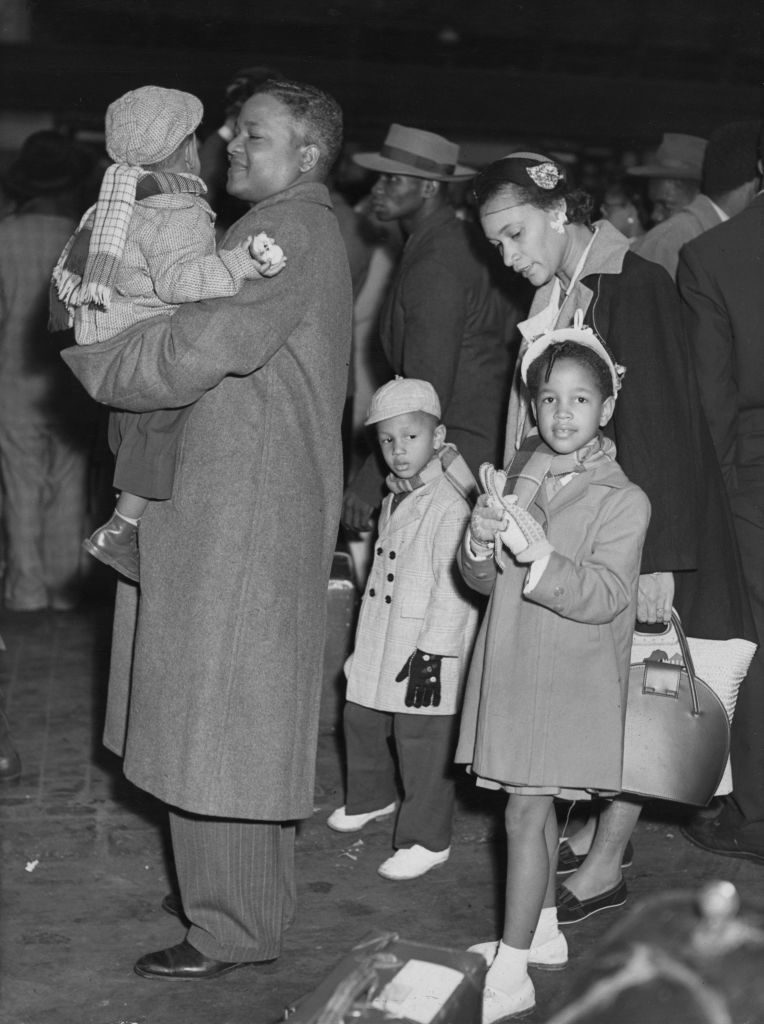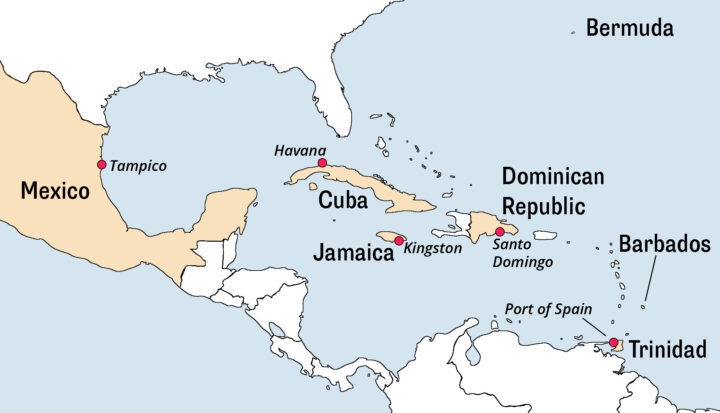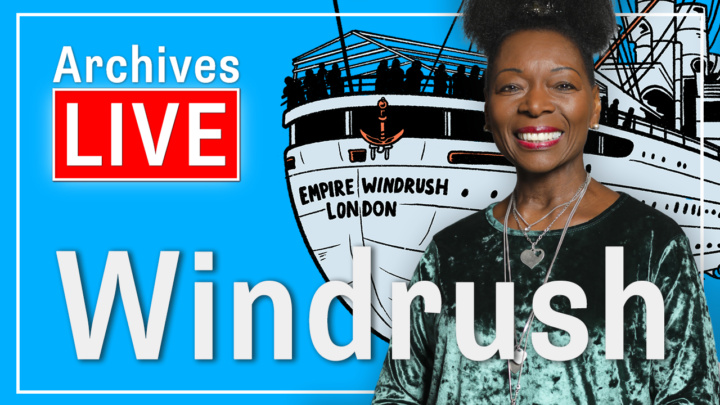
Archives Live: Windrush 75
Suitable for: Key stage 2
Time period: Postwar 1945-present
Curriculum topics: Diverse histories, The British Empire
Download: Lesson pack
Join Baroness Floella Benjamin for this live event which marked the 75th anniversary of the arrival of Empire Windrush to Tilbury dock.
Floella Benjamin is an acclaimed presenter, actress, author and the first woman from Trinidad to become a member of the House of Lords. Her bestselling book Coming to England can be found on the shelves of many classrooms.
For ArchivesLive, Floella explored the uniquely personal document that records her arrival as a ten-year-old in 1960. Learn about the history of Caribbean arrival to Britain through important documents from The National Archives, including the original passenger list for the Empire Windrush ship.
This event has been broadcast from the Clore Learning Centre at The National Archives. Supported by the Clore Duffield Foundation and the National Archives Trust.
Many thanks to Baroness Floella Benjamin OM, DBE, DL and Chloe Vethamony.
Broadcast:
Watch the recording of the live event on YouTube:
This resource pack prepares students to take part in the Archives Live: Windrush 75 event. There is an accompanying PowerPoint presentation with questions to facilitate pupil discussion and teacher notes, which we recommend you use. The activities should last 30-40 minutes.
The National Archives has other KS2 education resources about Empire Windrush and Caribbean migration: The Empire Windrush – The National Archives
Teacher notes
There is an accompanying PowerPoint presentation with questions to facilitate pupil discussion and teacher notes.
Language and content in the event
Please note that some of the language and terms used in the documents that will be explored in the event may be considered inappropriate or unacceptable today. The language has been preserved to accurately represent our records and to help us fully understand the past. The live event will explore sensitive themes relating to race and migration.
Tasks
Mystery document

Get students to discuss:
- What can you see?
- What type of document is it?
- When was it made?
Ideas for feedback discussion:
- Consider clothing the people in the image are wearing. Children might describe the clothing as smart and for cold weather.
- There is a suitcase visible, children can infer that they are going on a journey of some kind.
- Children might comment on the expressions on people’s faces. Mostly they seem happy and smiling, although the boy looks uncertain. The girl is the only person looking directly at the camera.
- Although the family are the focus of the image there are many people visible in the background. Many are wearing hats and are dressed formally. They seem like they are focused, or waiting for something.
- If children say this is a ‘picture’, you can clarify it is a photograph.
- Get children to consider when this was taken/made. Their clothing might help give a clue, or the fact it is black and white.
- Other questions to ask as to follow up: Where was the photograph taken? Why was the photograph taken?
Information about the photograph:
This is a photograph. You can see a family, the father is carrying a small child. They have arrived in England from Jamaica, in the Caribbean. This photograph was taken in about 1950.
Arrival of Empire Windrush ship
You could ask children what they know about the ‘Empire Windrush’ ship before you reveal more information. As a link to the mystery document you could say that two years before, a ship that came to be famous arrived in England.
Context:
In June 1948, 75 years ago, a ship called ‘Empire Windrush’ arrived at Tilbury dock in Essex, Britain. People disembarked the ship on 22 June 1948.
There were over 1,000 people on board. Most gave their last address as being in the Caribbean. There were men, women and children on board.
This was not the first time that people from the Caribbean had migrated to Britain. However it has become the most famous ship that sailed from the Caribbean after the Second World War.
Some of the countries in the Caribbean were British colonies at this time, meaning that lots of the people on board had British citizenship.
People who came to live and work in Britain from the Caribbean countries between 1948 and 1971 became known as the Windrush generation.
Key terms matching activity
Give students the key terms matching activity. They can do this individually or in pairs. This activity is designed to help with understanding key parts of the story of Empire Windrush and the Windrush generation.
Answers: 1D, 2E, 3G, 4A, 5H, 6B, 7F, 8C
Map of the Caribbean and Central America

- Hand out the map of the Caribbean and Central America (p. 12 in the resource pack). Get children to find the places that the ‘Empire Windrush’ ship stopped at on the map. These places are listed in the key term definition for ‘Empire Windrush’. There are some places listed that it did not stop at.
- As an extension, you could ask them to think about how long the journey might have taken in 1948 to Britain. (It took about 22 days.) Also, they could begin to consider what the journey might have been like.
Baroness Floella Benjamin
- Children watch this short film introducing Baroness Floella Benjamin: Black British History Icon – Floella Benjamin (Born 1949)
- Get children to discuss three interesting things they found out about Floella’s life with another student.
- Either show on the PPT or hand out the image collage of Floella Benjamin. Each image reveals something different about her life. Get students to discuss what they show about her. They might be able to make links to the video.
Images of Baroness Floella Benjamin (p. 13 in the resource pack):
- An image taken of Floella Benjamin as a child. She is sitting on the far right. Pictured are her siblings, mother and father. This was taken before her father left Trinidad for Britain.
- Floella Benjamin pictured with her hair in beads during her time as a children’s presenter of the programme ‘Play School.’ She was the first person on television to wear beads in her hair.
- Image of the front cover of Floella’s book for children called ‘Coming to England.’ There are different versions for younger and older children. The book tells her story of arriving in England on board a ship with her siblings, who travelled alone.
- Photograph of Baroness Floella Benjamin carrying the Olympic torch through Peckham in London in 2004. The Olympics were held in Athens, Greece.
- Photograph taken on 6 May 2023, showing Floella Benjamin carrying the sceptre as part of her special role in the coronation ceremony of King Charles III. Floella Benjamin became a member of the House of Lords in 2010 and is wearing her red robes.
Preparations for watching the event
- Ask children whether they have a migration story in their family. You can get them to think about how they know this story. For example, through historical documents like passports, stories passed down from relatives, or their own experiences.
- You can emphasise that children do not need to share their migration story if they do not feel comfortable doing so. Also, you can make clear the long history migration to Britain – everyone has a migration story in their family if you go back far enough into the past.
- Ask children why they think it is important to mark the 75th anniversary of Empire Windrush arriving to Britain.
Creative activity
After the event, here is a suggested creative activity that children can do.
- Design a front cover for a children’s book about a person from the Windrush generation. You could use Floella Benjamin’s book ‘Coming to England’ as inspiration.
Here are some people that children could focus on and links to resources that can be used. Or children might want to do their own research about people from the Windrush generation.
Samuel King
Samuel Beaver King travelled on board Empire Windrush. His many achievements include being involved in the creation of the first West Indian carnival at St Pancras Town Hall, London, being the first black mayor of Southwark in London and, together with Arthur Torrington, setting up the Windrush Foundation.
Lucilda Harris
Lucilda travelled on board Empire Windrush. There were fewer women than men on board the ship. Lucilda and her family contributed greatly to the community of Brixton where they lived.
Tom Douce
Tom travelled on Empire Windrush, however had no onward address and needed to organise somewhere to stay.. He stayed at the Clapham South underground shelter until he managed to get somewhere more permanent. Later he opened a successful shop with his wife.
Nick Collins
Nick travelled on board Empire Windrush at the age of 17. He had no onward address, so stayed at the Clapham South underground shelter. He enjoyed dancing and had a love for cricket.
Background
Black people have lived in Britain for over two thousand years. Some came to Britain with the Roman invasion in 43 CE and they became an important part of British society throughout the medieval ages and beyond. Evidence shows that Black people joined the armed forces, married in parish churches, made significant contributions to art and writing, and resisted and challenged the repressive laws of the day. We cannot tell the history of Britain without including their stories.
The ancestors of these Black Britons had been transported to the Caribbean as part of the transatlantic slave trade, of which Britain was a major participant. The Caribbean played a central role in the British Empire. As European settlement grew, more than 11 million enslaved people were transported to plantations across the Atlantic from Africa to America and the Caribbean over the following 300 years. Ideologies of race and the racial hierarchy developed and were entangled with the expansion of empire. Following the abolition of slavery the Caribbean became a centre for the indenture system, many workers were transported to islands in the Caribbean from Asia, working alongside the descendants of enslaved peoples.
In the early years of the First World War, many Caribbean men bought tickets to sail to Britain to join the army. The British West Indies Regiment was created, playing an important role in the conflict. Men from Nigeria, the Gold Coast, Sierra Leone, the Gambia and other parts of Africa, also fought for Britain. At the end of the war, many African and Caribbean soldiers decided to stay in Britain to make it their permanent home. Race riots broke out in parts of the country during the early months of 1919, as some white communities blamed black people for the shortage of work and housing caused by the war.
During the Second World War, black people from across the Commonwealth fought for Britain once more. Some were soldiers, whilst others came to support work on the Home Front such as factory production and nursing.
After the war, Britain needed to be re-built. By 1948, the Nationality Act was passed; allowing people from British colonies the right to live and work in Britain if they wanted. Most British subjects at this time were people of colour who lived overseas in places colonised by Britain. Other people from Europe were also invited to Britain. Many people from the Caribbean left their homes to begin a new life in Britain, bringing with them a wide range of skills. They filled jobs in the transport system, postal service and health service, helping Britain to re-build and recover.
These people are often called the Windrush generation, named after the ‘Empire Windrush’ ship that docked at Tilbury in June 1948. Windrush was not the first ship to bring Caribbean migrants to Britain; the Ormonde and Almanzora had arrived in Southampton the year before.
Between 1947 and 1970, nearly half a million people left their homes in the Caribbean to live in Britain.
The arrival of the ship ‘Empire Windrush’ is often seen as the start of this migration of Caribbean migrants from countries including Jamaica; Bermuda and Trinidad seeking jobs and a better life in this country. Jamaica for example, had high unemployment and a recent hurricane had caused huge damage. However, it is also important to remember that there were earlier lesser-known ships that carried post-war migrants from the Caribbean. Find out about these other ships in this National Archives blog post.
It cost £28 for travel on the troop-deck and £48 for cabin class travel on the Empire Windrush. The ship picked up passengers at Trinidad, Jamaica (Kingston), Mexico (Tampico), Cuba (Havana) and, finally Bermuda before arriving at Tilbury Docks on 22nd June in Britain. There were over 1000 people on board the ship, men, women and children. Arrival records show 802 gave their last address as being in the Caribbean. Some people, who had nowhere to go, were temporarily accommodated in London’s Clapham South tube station deep shelter.
News reels often show Caribbean arrivals being welcomed warmly, however documents at The National Archives show the negative response from some people in government to the arrival of people from the Caribbean. This contrasted with attitudes towards white migrants from British colonies. Arrivals from the Caribbean were viewed differently because of the colour of their skin.
Life was difficult for many people after the war. Rationing and shortages continued, people still queued for food. People therefore arriving from the Caribbean would have experienced this as well as leaving friends and family behind. The climate was also colder and wetter. Unfortunately, some Caribbean arrivals were made to feel unwelcome and treated unfairly and differently because of racism. Finding jobs and somewhere to live was difficult due to discrimination. Many were forced to accept employment with low wages or poor housing.
Despite these challenges, people from the Windrush generation contributed enormously to the recovery of Britain. They have had long-lasting impact on so many parts of British life, like food, music and sport.
The Archives Live event will focus on the story of Baroness Floella Benjamin. Floella Benjamin is an acclaimed presenter, actress, author and the first woman from Trinidad to become a member of the House of Lords. She wrote the bestselling book Coming to England about her experience of arriving in Britain. In the event Floella will explore the uniquely personal document that records her arrival to Britain as a ten-year-old in 1960.
Back to top
Suitable for: Key stage 2
Time period: Postwar 1945-present
Curriculum topics: Diverse histories, The British Empire
Download: Lesson pack
Archives Live: Tudors
Student resource pack
